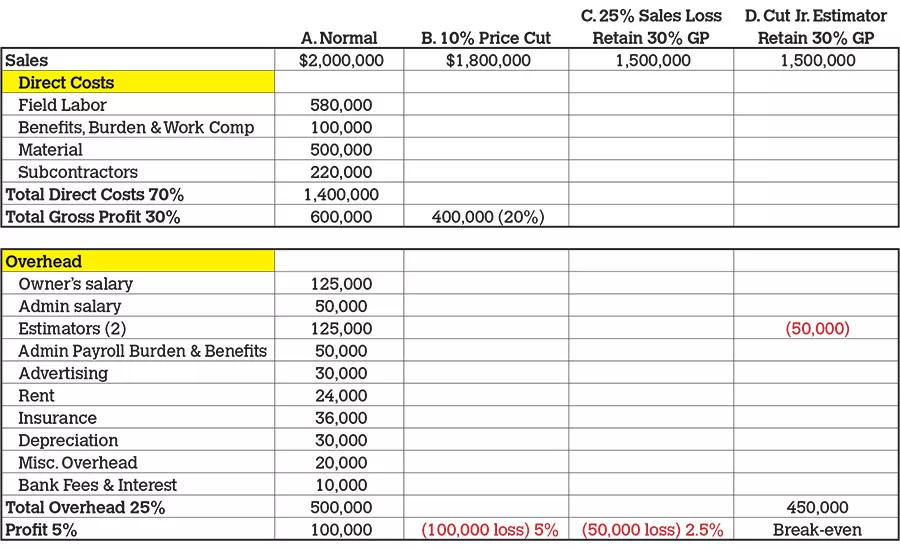Avoiding Financial Suicide as a Roofing Contractor

As the economy tightens, contractors tend to cut prices to find work. Many of these contractors really do not understand their costs, and such random cutting of costs creates financial suicide. It took years to build the organization and develop good people. Being a nice guy and taking care of people can quickly drive contractors into heavy losses. Trying to sell or “volume” your way out of a down market is a dangerous strategy.
I have a created a sample profit and loss chart (see next page). While this format may not perfectly match your own numbers, it makes for a good industry example and helps show the impact of price cutting and lower margins. We have used a company with normal sales of $2 million (Column A) and gross profit of 30% (our customers tend to be much higher, but we find the industry at large closer to 30%). The company has an overhead of 25% including $125,000 for the owner’s salary and a net profit of $100,000, or 5%. And yes, I kept the math simple; it is easy to follow the math.
Column B shows the impact of a 10% price cut. The company is doing the same amount of work but at a 10% lower price. Note, sales drop to $1.8 million and gross profit to 20%. Now the company shows a $100,000 loss (5%).
Column C shows the impact of a drop in sales of $500,000, but the company maintained its 30% margin. While sales are down 25%, the loss of $50,000 is less than the $100,000 loss created by the 10% price cut. Column D shows that cutting overhead by $50,000 — the cost of one junior estimator — the company now breaks even with 25% less in sales because the 30% gross profit was maintained.
I don’t want to overburden you with numbers, but this is the reality. As painful as overhead cuts might be, cuts in overhead are the best way to reach break-even and get out of a loss situation. Every dollar cut out of overhead is money in your pocket and goes directly to the bottom line. For every dollar of sales gain, you only receive the gross profit percentage of the sale, provided you maintain control of your direct costs.
I have been through numerous downturns. In each one, I have seen the following failures:
- Failure to cut overhead soon enough. Overhead cuts are painful and tough, but trying to keep everyone may also mean that the company goes under and everyone loses their job. Remember, if the business fails, the bank is going to foreclose on your house, not your employees’ homes.
- Failure to maintain labor percentages. Common sense tells you that if you keep your best people, you will put the jobs in for less labor. This is not necessarily true. Your good people are generally paid more per hour, so if you only keep foremen and lead people, your average hourly wage will dramatically increase. Too many chiefs on one job can get in the way of production rather than help it. Revaluate your new hourly wage rate and hours required to bring the job in on labor budget. If your average hourly wage went up 10%, you have to reduce production hours 10%. Clearly communicate this new labor target and make sure jobs hit it.
- Failure to properly manage estimating. Never tell an estimator if he or she doesn’t get some work, they will be let go. If the estimators cut prices to get work, it may be months before you realize you are stuck with a bunch of unprofitable work. Manage your estimating process intelligently. Rather than try to bid everything, focus on the jobs where you have a chance and creatively, but intelligently, think of ways to beat production. Focus on where you have a chance to win.
In closing, math is science. It’s like gravity. Jump off a cliff and you are probably going to die. Haphazardly cutting your prices is no different.
Looking for a reprint of this article?
From high-res PDFs to custom plaques, order your copy today!




